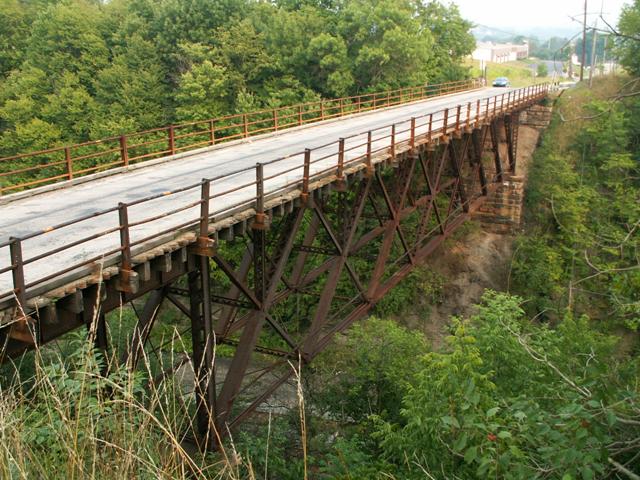We Recommend:
Bach Steel - Experts at historic truss bridge restoration.
BridgeHunter.com Phase 1 is released to the public! - Visit Now
Monastery Drive Bridge

Primary Photographer(s): Nathan Holth and Rick McOmber
Bridge Documented: August 1, 2007
Rural: Westmoreland County, Pennsylvania: United States
Metal Pin-Connected Double-Intersection Warren Deck Truss, Fixed and Approach Spans: Metal Deck Girder, Fixed
Not Available or Not Applicable
157.2 Feet (47.9 Meters)
228.0 Feet (69.5 Meters)
18.4 Feet (5.61 Meters)
1 Main Span(s) and 2 Approach Span(s)
647217089800070

View Information About HSR Ratings
Bridge Documentation
This bridge no longer exists!
View Archived National Bridge Inventory Report - Has Additional Details and Evaluation
View Historic American Engineering Record (HAER) Documentation For This Bridge
HAER Data Pages, PDF
This historic bridge was demolished and replaced in 2010!
One of the most unusual bridges in this region that is rich with historic bridges, this structure is an extremely rare example of a pin-connected double-intersection Warren. The double Warren is uncommon enough, but many examples of this type feature riveted connections and date to the early 20th Century. Thus, this c. 1890 structure is an extremely early and rare pin-connected example of the type. It also retains excellent historic integrity with little alteration detected.
Pennsylvania has a habit of picking its rarest historic bridges and targeting them for demolition, and this bridge is no exception. After following the prescribed federal guidelines for demolishing a historic bridge, this bridge was offered to a third party for relocation and preservation. As one might expect, few private individuals or nonprofit groups have the resources to preserve a structure like this. For this reason, this process of bridge marketing is largely ineffective. Our government has been charged with the people and Congress to care for this country's heritage as outlined through various historic preservation legislation. However, there are serious flaws in the legislation. A bridge such as the Monastery Road Bridge should not face demolition because local residents and groups don't have $1,000,000 laying around in the loose change jar. A bridge like the Monastery Road Bridge should be preserved by its government owner, perhaps with grants and assistance from higher levels.
While this bridge may not be acceptable as a vehicular bridge, it certainly could and should be restored, either here or in a new location, for non-motorized traffic.
The National Bridge Inventory gives a construction date of 1920 for this bridge, which is obviously incorrect, but it might reflect a rehabilitation date, or further might confirm the thoughts of the Historic Bridge Inventory that this bridge was originally a rail bridge, perhaps located somewhere else. 1920 might be when it became a highway bridge on Monastery Road.
Information and Findings From Pennsylvania's Historic Bridge InventoryDiscussion of Bridge The main span of the ca. 1890, 3 span, 228' long bridge is a 157' long, pin-connected double intersection Warren deck truss with subdivided panels. The approach spans are built up deck girders. The bridge is supported on ashlar abutments. The truss is 20'-9" deep. The design of the flooring system, where the asphalt deck is supported on railroad ties suggests that the bridge was originally a rail carrying facility. The bridge is significant as a rare example of type and design. It also appears to be remarkably complete, and its idiosyncratic design illustrates the evolution of metal truss bridges. Discussion of Surrounding Area The bridge carries a 2 lane road over 2 active tracks of the former Pennsylvania Railroad main line now operated by Conrail and an access road in a sparsely developed, rural area. A ca. 1970 factory is located beyond the southeast quadrant. PHMC has determined eligible the Main Line from Philadelphia to the Ohio State Line (DOE 9/14/93), but no period of significance or definition of contributing and noncontributing resources was part of that determination. Bridge Considered Historic By Survey: Yes |
![]()
Photo Galleries and Videos: Monastery Drive Bridge
Bridge Photo-Documentation
A collection of overview and detail photos. This photo gallery contains a combination of Original Size photos and Mobile Optimized photos in a touch-friendly popup viewer.Alternatively, Browse Without Using Viewer
![]()
Maps and Links: Monastery Drive Bridge
This historic bridge has been demolished. This map is shown for reference purposes only.
Coordinates (Latitude, Longitude):
Search For Additional Bridge Listings:
Bridgehunter.com: View listed bridges within 0.5 miles (0.8 kilometers) of this bridge.
Bridgehunter.com: View listed bridges within 10 miles (16 kilometers) of this bridge.
Additional Maps:
Google Streetview (If Available)
GeoHack (Additional Links and Coordinates)
Apple Maps (Via DuckDuckGo Search)
Apple Maps (Apple devices only)
Android: Open Location In Your Map or GPS App
Flickr Gallery (Find Nearby Photos)
Wikimedia Commons (Find Nearby Photos)
Directions Via Sygic For Android
Directions Via Sygic For iOS and Android Dolphin Browser
USGS National Map (United States Only)
Historical USGS Topo Maps (United States Only)
Historic Aerials (United States Only)
CalTopo Maps (United States Only)

